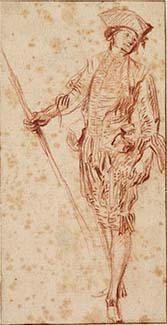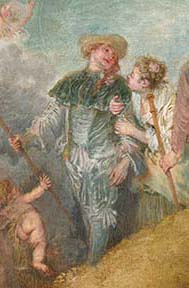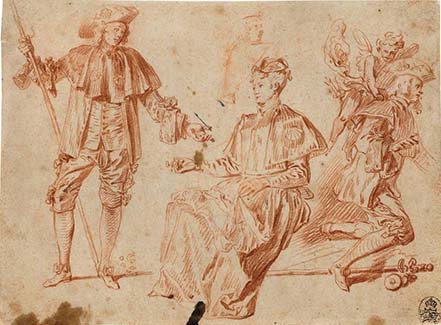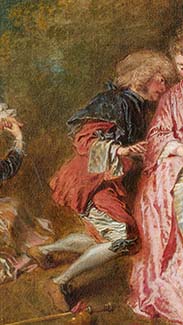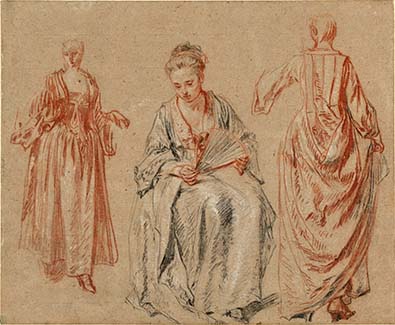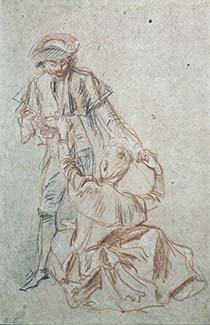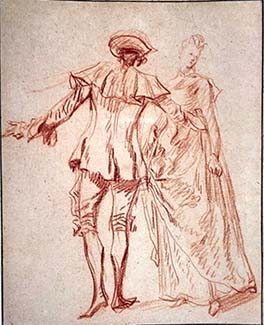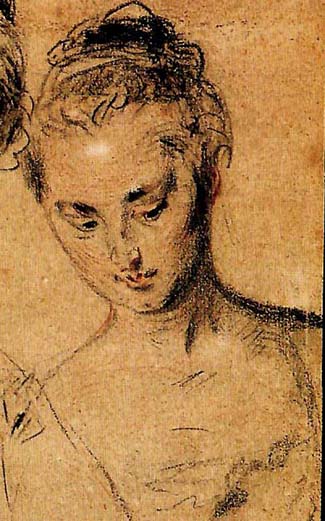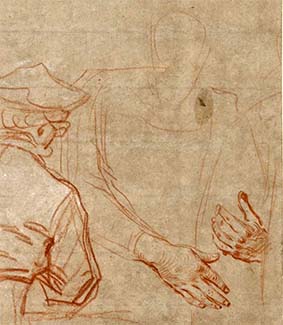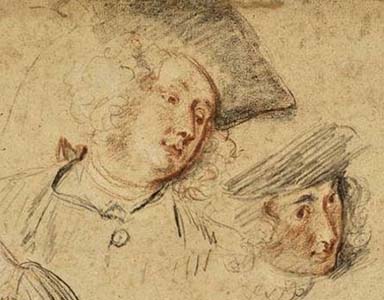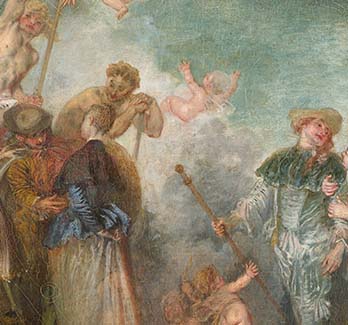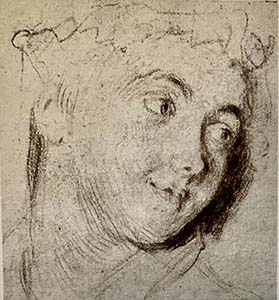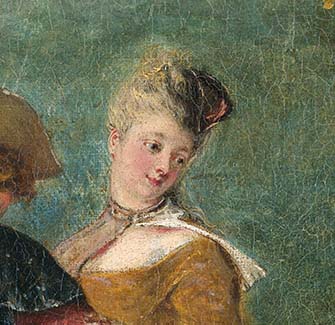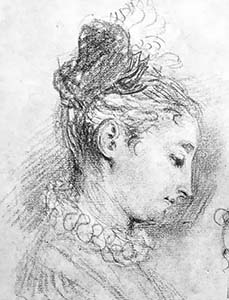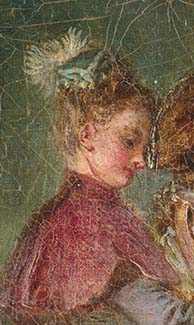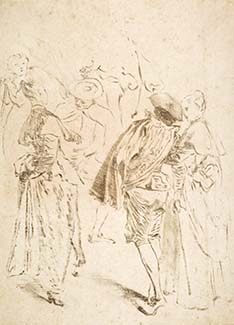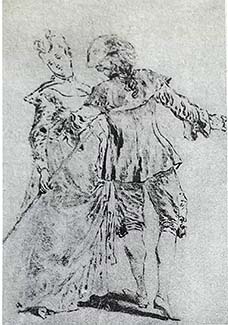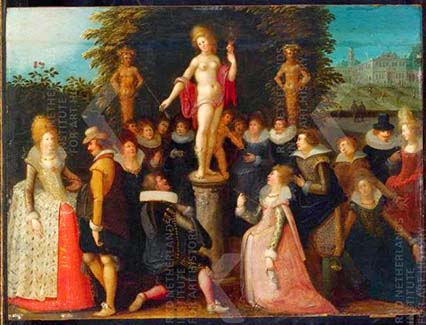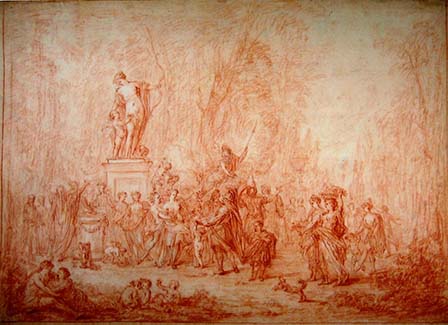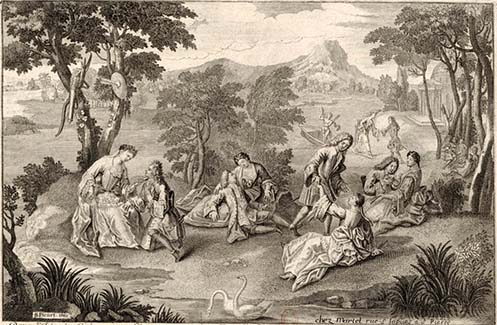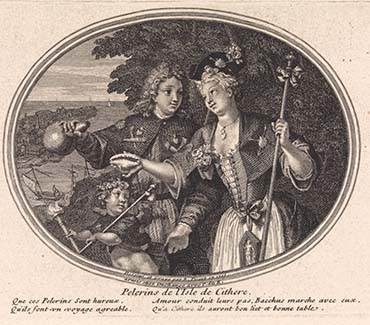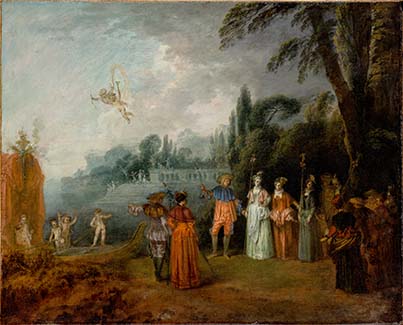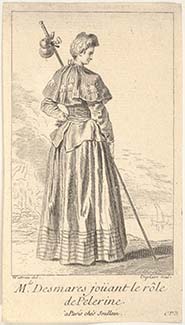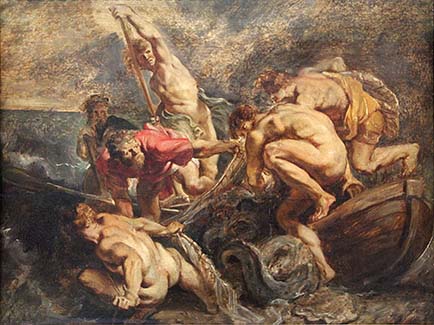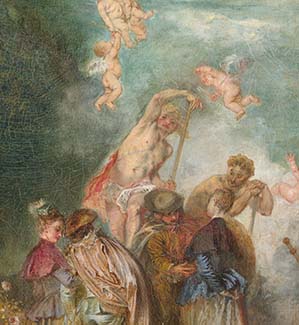
- Home Page
- Accepted
Paintings & Copies - Doubtful
Attributions - Doubtful Textual References
- Alternative
Titles - Collectors &
Museums - Bibliography
- Search Abecedario
- Watteau &
His Circle
Le Pèlerinage à l’isle de Cythère
Entered July 2021; revised May 2025
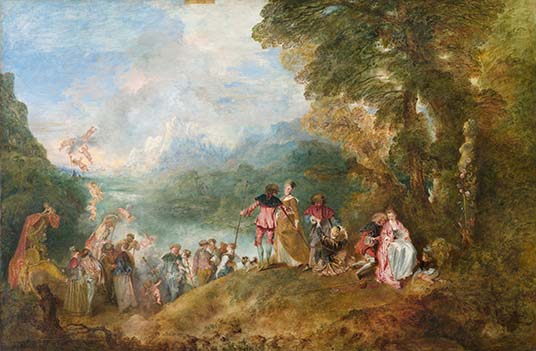
Paris, Musée du Louvre, inv. 8525
Oil on canvas
129 x 194 cm
ALTERNATIVE TITLES
The Embarkation to Cythera
The Embarkation from Cythera
L’Embarquement de Cythère
L’Embarquement à Cythère
L’Embarquement pour Cythère
The Voyage to Cythera
RELATED PRINTS
Watteau’s Pèlerinage à l’isle de Cythère, submitted to the Royal Academy and remaining in their possession, was not engraved for the Jullienne corpus. Instead, the artist’s second version, the one now in Berlin but then in Jullienne’s collection, was engraved; it was not only more easily accessible but also in Jullienne’s self-interest.
Charles Joshua Chaplin (after Watteau), Embarquement pour l’ile de Cythère, engraving, 52.5 x 70 cm.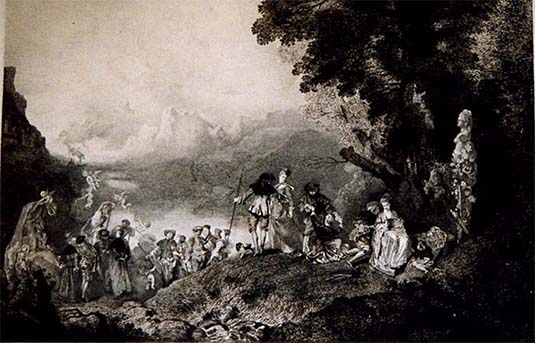
The Louvre version was engraved in the second half of the nineteenth century by Charles Joshua Chaplin (1825-1891). The legend beneath the image declares: “WATTEAU PINXT . . . EMBARQUEMENT POUR L’ILE DE CYTHÈRE CHALCOGRAPHIE IMPERIALE . . . CHAPLIN SCULPSIT”
PROVENANCE
Paris, Académie royale de peinture et de sculpture; received from the artist in August 1717 as his morceau de réception. Although removed from the Louvre c. 1800, it was returned there in 1816.
EXHIBITIONS
Washington, Paris, Berlin, Watteau, 1684-1721 (1984), cat. P 61 (as Watteau, Pilgrimage to the Island of Cythera [Le Pèlerinage à l’isle de Cythère], lent by the Musée du Louvre).
Lens, Musée du Louvre-Lens, Dansez, embrassez (2015), cat. 24 (as Watteau, Pèlerinage à l’île de Cythère, lent by the Musée du Louvre.
SELECT BIBLIOGRAPHY
Hédouin, “Watteau” (1845), cat. 3.
Horsin-Déon, De la conservation et de la restauration des tableaux (1851), 192-95.
Hédouin, Mosaïque (1856), cat. 7.
Goncourt, Catalogue raisonné (1875), under cat. 128.
Mollet, Watteau (1883), 33-34.
Mantz, Watteau (1892), 74, 101-05, 114, 171-72.
Fourcaud, “L’Existence de Watteau” (1901), 115-17.
Staley, Watteau (1902), 26, 73, 127, 155.
Josz, Watteau (1903), 374, 378-79, 383, 441, 472.
Séailles, Watteau (1901), 93-96.
Pilon, Watteau et son école (1912), XII, 31-32, 70, 84, 87-90, 106-07, 114.
Zimmerman, Watteau (1912), pl. 59, 178.
Pilon, “Les Origines de l’Embarquement” (1921), 83-94.
Dacier, Vuaflart, and Hérold, Jean de Jullienne et les graveurs (1921-29), under cat. 110.
Réau, “Watteau” (1928), cat. 155.
Eisenstadt, Watteaus Fêtes galantes (1930), 142-44.
Parker, Drawings of Watteau (1931), 32-34.
Jamot, L'Embarquement pour Cythère (1937).
Vallée (Adhémar), “Sources de l’art” (1939), 67-74.
Florisoone, “Embarquement pour Cythère” (1939), 303-04.
Michel, Aulanier, and de Vallée (Adhémar), Watteau, L’Embarquement (1939).
Florisoone, “L’Embarquement pour l’île de Cythère” (1939-40), 303-04.
Adhémar, L’Embarquement (1947).
Florisoone, Le Dix-huitième siècle (1948), 34-35.
Adhémar, Watteau (1950), cat. 192.
Godfrey, “Two Versions” (1951), 5-7.
Tolnay, "L'Embarquement pour Cythère," (1955), 97-102.
Gauthier, Watteau (1959), pl. 42, 43.
Mathey, Watteau, peintures réapparues (1959), 18, 69.
Levey, “Watteau’s Embarkation for Cythera” (1961), 180-185.
Mirimonde, “Statues et emblèmes” (1962), 18-19.
Kunstler, “L’Embarquement pour Cythère” (1964), 44-55.
Eidelberg, Watteau’s Drawings (1965), 66-67, 177-78, 188-96.
Vienna, Oberes Belvedere, Kunst und Geist (1966).
Brookner, Watteau (1967), 9, 12, 18, 23, pl. 26, 27.
Macchia and Montagni, L’opera completa di Watteau (1968), cat. 168.
Ferré, Watteau (1972), 3: cat. A 27.
Kalnein and Levey, Art and Architecture (1972), 20-21.
Boerlin-Brodbeck, Watteau und das Theater (1973), 200-204, 219-221.
Mosby, “Claude Gillot's Embarkation” (1974), 49-56.
Ferraton, “Watteau” (1975), 81-91.
Le Coat, “Le Pèlerinage” (1975), 9-23.
Adhémar, “Watteau, les romans et l’imagerie de son temps” (1977), 165-72.
Ostrowski, "Pellegrinaggio a Citera” (1977), 9-22.
Bauer, Rokokomalerei (1980), 23-51.
Sloane, “Watteau’s Embarkation”(1981/82), 289-99.
Roland Michel, Watteau (1981), cat. 212.
Tomlinson, La Fête galante (1981), 110-26.
Roland Michel, Watteau (1984), 35, 45, 49-50, 70, 111, 120, 192, 201-03, 221, 229, 269-72, 311.
Posner, Watteau (1984), 9, 181-95, 201, 203.
Grasselli, Drawings of Watteau (1987), 263-71, cat. 66, 158, 169, 196, 225-26.
Moureau and Grasselli, Watteau (1987), passim.
Cowart, “Watteau’s Pilgrimage” (2001), 461-478.
Temperini, Watteau (2002), 108-9, cat. 81.
Vogtherr, Französische Gemälde (2011), under cat. 6.
Glorieux, Watteau (2011), 114, 120, 122.
Sheriff, “Love Hurts,” in MacDonald, French Art of the Eighteenth Century (2016), 44-45.
RELATED DRAWINGS
In 1984 Rosenberg claimed that “Watteau used many of his drawings for this composition.” Indeed, one might think there would have been an extensive series of preliminary drawings for the Pèlerinage, given that the painting was intended for the Academy. Yet this is not the case. However, critics have not failed to associate many of Watteau’s studies with the Louvre painting. It is a fluid list, and with each telling of the story new models are proposed and older associations are abandoned. One only need compare the list of preparatory drawings compiled by Rosenberg in 1984 with the one constructed by Rosenberg and Prat in 1996.
A number of drawings of pilgrims were made early in Watteau’s career for L’Ile de Cythère, his painting now in Frankfurt, and for etchings in the Figures françoises et comiques. Although his Pèlerinage was executed a few years later, he evidently returned to these early works when creating his morceau de réception.
A drawing in the British Museum (Rosenberg and Prat 406), a study quite possibly for a pilgrim in the foreground of the Frankfurt picture, was used for the pilgrim near the center of the Louvre composition. The man's general posture—the distinctive turn of his torso and thrown-back head—and the angled staff are quite similar. Whereas in the drawing he wears only the barest suggestion of the traditional pilgrim’s cape, that is emphasized in the painting. In the transition from the drawing to the painting and typical of Watteau’s maturing style, he also gained weight.
A sheet in Dresden (Rosenberg and Prat 139) is another and very important example of how Watteau fell back on his earlier drawings when composing his morceau de reception. At the left a male pilgrim gestures as though encouraging his seated companion to rise and go with him. In L’Ile de Cythère there is no interaction between seated and standing figures, but in the Louvre painting that idea is played out in the foreground. More striking, Watteau took over the figure of the man kneeling before his unseen sweetheart at the right of the Dresden sheet and used it for the pilgrim at the right in the Louvre picture. In short, the Dresden sheet marks a median stage between Watteau’s L’Ile de Cythère and Le Pèlerinage.
A standard type of drawing that Watteau turned to for the Pèlerinage is a triple study of women, now in the Getty Museum (Rosenberg and Prat 466). The women are probably not all of the same model, and they appear to take random poses, not ideas specifically intended for the Louvre painting. Without changing the figure of the seated woman, Watteau borrowed her for the bashful pilgrim in the foreground of the painting.
Two of Watteau’s drawings were made specifically for the Pèlerinage. One, now in the British Museum (Rosenberg and Prat 513) is a study for the man helping his still-seated partner rise to her feet. The other drawing (Rosenberg and Prat 514) depicts a male pilgrim walking forward and, with a sweeping gesture, motioning his companion forward, though she looks backward. In the second drawing it would seem that Watteau first drew the man, then added the woman—but only as a lighter, less defined figure—as though trying out the idea of their being posed together. These figures stand at the crest of the foreground hill. Both drawings were executed with élan, perhaps drawn from imagination rather than from models. From the start both were intended for the Louvre painting, as shown by the pilgrims’ costumes they wear. The exceptional nature of these two studies—each showing two figures as they would appear together in the painting—suggests the unusual care that Watteau took in preparing his morceau de réception. Moreover, although these are the only two such examples to survive, there may have been others for this painting.
A good number of other Watteau drawings have been associated, often too freely, with Le Pèlerinage. For example, an evocative study of a woman’s head now in the collection of the Fondation Custodia (Rosenberg and Prat 557) has been associated with the seated woman in the foreground of the Louvre painting. But although the features seen in this drawing correspond in general with those in the painting, why would Watteau have needed recourse to his drawing when, as we have already seen, he had a drawing of the entire woman’s body, including her face, at his disposal?
Similarly, it has been theorized that a lightly drawn sketch on a sheet in the Ashmolean Museum (Rosenberg and Prat 539) was used to flesh out the hands of the man helping a female pilgrim to board the boat. But the hands in this drawing do not correspond in significant ways with the painted hands. In fact, does the drawing represent a man actually holding a woman, as is generally claimed? To my mind, the resemblance to a man holding bag pipes is greater, and that would be thematically appropriate for the other two studies on the Ashmolean sheet, which are studies of a violinist.
Two studies of a man’s head on a sheet in the Louvre (Rosenbergt and Prat 487) have been associated with the Louvre painting. That at the right has been linked to the pilgrim helping a woman enter the boat, but the man in the painting has a very different physiognomy. The head at the left has been linked with the pilgrim in the painting, but the posture of the latter figure is quite different. Rather, like Grasselli, we believe that this head was used for a figure in the middle cluster of pilgrims in the Berlin version of Le Pèlerinage.
Similarly, the isolated head of a woman, evidently cut from a larger sheet with other studies (Rosenberg and Prat 572), has been compared with the head of the woman standing at the crest of the hill, turning to look back. Yet, while general similarities exist, there are significant differences in the carriage of the head and the head, in the painting appears less fleshy.
Another study of a woman’s head (Rosenberg and Prat 574) has been associated with the pilgrim at the far left of the Louvre composition, but, like Grasselli, we would reject this idea: the painted head is turned at a different angle, tending toward a more three-quarter view.
Also pertinent to our understanding of Le Pèlerinage are the two oil counterproofs that were pulled from the canvas after the artist had transcribed the major lines of his drawings to it. To transcribe his drawings, the artist probably drew them in black chalk on the primed canvas and then reinforced the lines with dark brown oil paint. This essentially unfinished state can be seen in some of Watteau’s paintings, such as the right side of the Concert in Berlin. Then, before the colored pigments were laid in, Watteau laid drawing paper over these areas and rubbed them to take impressions of this preliminary state.
The first oil counterproof is of the central group of four pilgrims and two boatmen at the center of the composition. The second is of the couple at the crest of the foreground hill, he gesturing forward, she turning back. Because such oil counterproofs are halfway between drawings, and paintings, they are difficult to place. Parker and Mathey included them in their catalogue of Watteau’s drawings whereas Rosenberg and Prat did not. Parker and Mathey accepted them as genuine, as did Eidelberg, Grasselli, and Vogtherr, but Rosenberg and Prat rejected the second example, claiming that it was pulled from a bad copy of the Louvre painting, a strangely negative view—especially since the examples' measurements correspond to those of the same figures in the Paris and Berlin paintings.
Although only two oil counterproofs from the Louvre painting survive, this does not rule out the possibility—or even the probability—that others were made. The two surviving examples seem to indicate that while working on the Louvre canvas Watteau was already planning to paint a second version, and he executed these oil counterproofs with that goal in mind. If such is the case, then it is only logical that he would have struck oil counterproofs of all the figures in the Pèlerinage.
REMARKS
Le Pèlerinage is one of the best documented works in Watteau’s oeuvre. When he was agrée to the Royal Academy, he was required to submit a painting but, instead of specifying its subject, the Academy left the choice to the artist, “à sa volonté.” Although this obligation was supposed to be fulfilled within six months, Watteau dawdled. The Academy reminded him on January 5, 1714, again on January 5, 1715, and a third time on January 25, 1716. Evidently vexed, on January 9, 1717, the Academy complained and demanded that Watteau and other delinquent candidates come forward and explain the reasons for their delays. Watteau was given an additional six months to comply. Finally, on August 28, 1717, he submitted his painting. Its reception was duly noted in the Academy’s records as “Le pelerinage a l’isle de Cithère,” but this title was subsequently struck though and replaced by “une feste galante.” This chronicle, extending over five years, is remarkable because nowhere else in Watteau’s oeuvre is there such a precise chronology. Of course, it leaves open the question of when the artist actually began work on his painting, but the evidence suggests that he did nothing prior to 1717.
When Watteau chose the theme of a pilgrimage to Cythera, he was guided by several different traditions. In depicting the cult site of Venus, goddess of love, who was born from the sea and first stopped on land on the island of Cythera, he was following a well-known tradition in European, especially Flemish, art. The many paintings by Nicolas de Caullery testify to the popularity of this theme in seventeenth-century art. In these naïve paintings, richly dressed courtiers assemble and venerate her statue. Watteau’s master, Claude Gillot, made a specialty of scenes in which the pagan gods are honored by mortals, as well as by woodland nymphs and fauns. Unfortunately, while Gillot depicted the worship of Diana, Pan, and other gods, he apparently failed to devote a composition to the veneration of Venus. On the other hand, Jean Jacques Spoede, a disciple of Gillot and a friend of Watteau, composed many variations on this theme, though most date from the 1720s. Spoede's drawings and paintings demonstrate that the pictorial tradition of such scenes of homage to pagan gods was continuous.
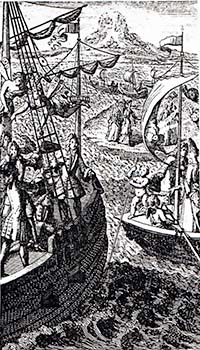
Unidentified French artist, frontispiece to Paul Tallemant, Le Voyage de l’Ile d’Amour, 1713.
Perhaps more germane, French popular literature and imagery took up the theme of pilgrimages to Cythera with great gusto. As Adhémar pointed out, the abbé Paul Tallemant had wide success with his Voyage de l’Ile d’Amour, which appeared in 1663 and then in subsequent editions in 1665 and 1713, the latter just before Watteau executed his morceau de reception. The frontispiece for the third edition, albeit gauche, sets the pictorial stage for Watteau’s far more sophisticated rendering.
Still closer to home, the theme of pilgrims to Cythera was popular among French printmakers in the years before and after 1700. One of the most successful of these was an engraving by Bernard Picart. Its repertoire of couples—a man kneeling before his sweetheart, another helping his companion rise, a third recumbent and enraptured by his partner—predict the actions of Watteau’s characters. Other, less ambitious prints of paired men and women dressed as pilgrims appeared in great abundance and were destined not only for print collectors, but also for craftsmen such as painters of small boxes, fans, and other modish trinkets. These images establish that this was a popular theme at the beginning of the eighteenth century: in all probability, Watteau was aware of at least some of them. Moreover, they were straightforward representations of people seeking partners and love. No deeper meaning was attached to them, and certainly no hint of the corona of melancholy that the Goncourts sought to impose on Watteau’s art.
The theme of townspeople traveling to Cythera to find eternal love also appeared in the contemporary theater, most famously in Florent Dancort’s play, Les Trois Cousines, where three young women, all cousins, make the voyage. First presented on the Paris stage in 1700, the play was revived in 1709. Watteau portrayed the final scene of Act 2 of the staged presentation in his L’Ile de Cythère, now in Frankfurt. Here the players are dully arranged across the stage, before a painted backdrop—much as they would have been in the theater. Watteau’s designs of actors in the roles of pilgrims also appear in some of the engravings in his Figures françoises et comiques. In these works, and especially in his painting, there is no spatial play, and none of the physical or emotional content so skillfully added a few years later to Le Pèlerinage.
When Watteau came to paint his picture for the Royal Academy, he called upon these different pictorial traditions and currents of thought. Although by now his fame was well established as a painter of fêtes galantes—in essence of genre painting—he undoubtedly sought to elevate the category incorporating allusions to classical mythology. The established hierarchy at the Academy, after all, placed history painting at the summit art: the great deeds of great men were the highest achievement, and below that fell portraiture and genre subjects. Still life and landscape subjects, the portrayal of the inanimate, occupied the lowest levels. Ironically, although the Academy accepted the painting and the artist, according him the traditional title of painter of history, the title of his work, “Pèlerinage à l’Ile de Cythère,” was crossed out and replaced by “Fete galante.” Elsewhere the Academy records also describe Watteau’s picture as “un tableau représentant une fête galante.” Was this an intended demotion? In subsequent eighteenth- and nineteenth-century histories, it has often been claimed that Watteau, Pater, and Lancret were received into the Academy each with the title of “peintre de fêtes galantes,” and through this error the term “fête galante” ultimately came to be attached to such subjects. While factually incorrect, the legend still persists today.
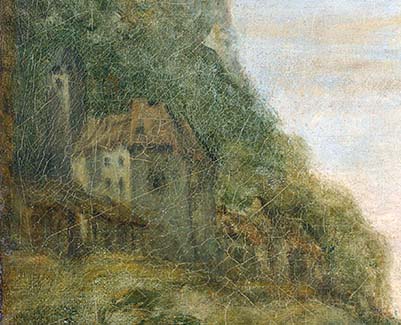
Watteau, Le Pèlerinage à l’ile Cythère (detail).
Watteau’s painting marks the emergence of his mature style. Unlike his earlier rendition in Frankfurt, which is a flat, planar composition with stiffly posed figures, the Louvre painting is fully three-dimensional. The figures are arranged on a diagonal, bringing us from the foregound back into the distance; like an example from Heinrich Wölfflin’s Basic Principles of Art History, the diagonal structure exemplifies the Baroque principle of composition. The painting's verdant hills and Alpine distance owe much to Watteau’s study of Venetian art, especially the landscape drawings of Titian and Domenico Campagnola. The castle perched high on a hill at the left was probably copied from one of these drawings (the identical buildings also appear in Watteau’s L’Amour paisible in Potsdam).
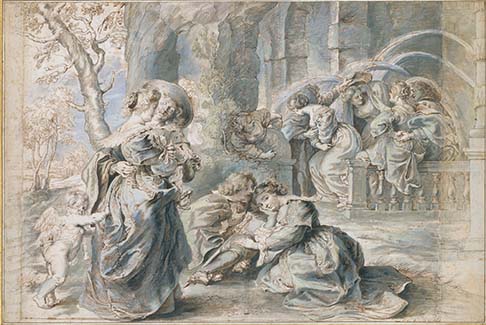
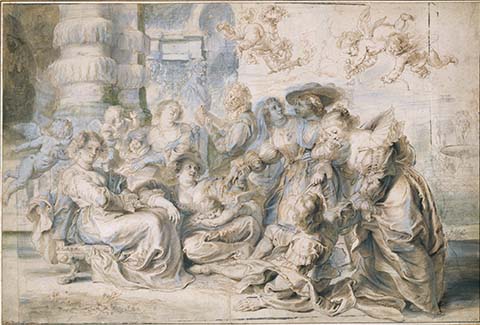
Also, one cannot overlook the influence of Rubens. As has often been noted, a jewel of the Crozat collection was the large, two-part drawing after the Flemish master’s Garden of Love, prepared by Rubens himself for the woodcut that was issued after his composition. These drawings would have been known to Watteau because his patron, Pierre Crozat owned them. Rubens’s fleshy women and men, as well as the abundance of playful putti, appear to have greatly influenced Watteau. Of course, neither Watteau’s men or women are as robust as Rubens’, they are more slender and their gestures more refined, as befits a French painting of the eighteenth century.
Watteau’s oarsman holding the boat steady, his arm raised over his head, drapery fluttering across his nude body, is specifically indebted to a Rubens invention; he derives the figure from the oarsman in Rubens’ Miraculous Draught of Fishes, probably not his painting in Cologne or the modello in Cologne but a drawing after Rubens's composition. Here again, Watteau’s figure is younger and less muscular, and even his fluttering drapery is less palpable, more delicate.
Even though the Louvre picture was not engraved for Jullienne's Oeuvre gravé (that honor fell to Watteau’s version of the Pèlerinage now in Berlin), it was one of the artist’s best-known paintings. It enjoyed a unique aura, both because of its special history and also because it was the only example of Watteau’s art in the Louvre thoughout most of the nineteenth century, a situation that did not change until the LaCaze donation in 1869. Romantic critics were especially fond of Rococo art and Watteau, and just as they fostered a pessimistic view of Watteau as an isolated, doomed artist they also interpreted the Pèlerinage as embodying the tragic aspects of the search for love. According to them, the pilgrims were setting forth for Cythera, but it was a hopeless quest, symbolized by the sun setting over the horizon.
All this changed abruptly in 1961 when Michael Levey reconsidered the painting’s narrative. He argued most sensibly that the pilgrims were not setting forth on a voyage to Cythera; they were already there. This is denoted both by the herm statue of Venus, and the garlands of roses draped over it—evidence that the pilgrims had already made their offerings to the goddess. That all the pilgrims are arranged as couples indicates that their prayers were answered and they have found love. Their goal achieved, they now return to their ship. The setting sun marks the close of the day’s successful outing. Confirmation of Levey's brilliant analysis is found in the title assigned to Watteau’s painting when he presented it to the Academy. It is not an “Embarquement à Cythère” or an “Embarquement vers Cythère,” both of which titles imply the direction or start of the trip. Rather, it is “Pèlerinage à Cythère,” a more neutral term apropos of direction or time.
Despite Levey’s well-fashioned argument, there have since been doubters and naysayers. In a tendentious and unpersuasive essay, Claude Ferraton claimed that while the Paris version of the Pèlerinage represented pilgrims embarking on a voyage to Cythera, the Berlin version represented the pilgrims returning from the sacred island. Surprisingly, Rosenberg announced that he thought that “both interpretations are correct: the painting is as much a departure toward the isle as a departure from the isle, a pilgrimage as much as an allegory.” Likewise, Glorieux separated the two paintings, seeing the Louvre version as a melancholic departure from Cythera and the Berlin version as a joyous departure for Cythera.
In his analysis of Watteau’s iconography, de Mirimonde analyzed the Louvre Pèlerinage in fairly reasonable terms (something that cannot be said of all his interpretations of Watteau paintings). He pointed out that the prow of the boat is like a bed, that the sky is filled with cupids, some with torches symbolizing the fire of passion, and, above all, the painting is a celebration of the rose–garlands of which are wound around the term of Venus much as they were offered to Venus in antiquity.
Over the last half century other critics have ventured alternative interpretations that go in quite different directions. Ostrowski sought to identify Watteau’s two paintings with a macabre Dance of Death. Equally unconvincing, Sloan argued that the boat in the Louvre painting is not a ship but an airborne vessel. Rosenberg summed up the situation in 1984, looking back over the arguments advanced by Bauer, Le Coat, the 1982 Frankfurt exhibition, and Posner: these articles are often very long and impenetrable. In recent years, interpretations of the Louvre painting have veered in yet other directions, toward the idea that Watteau was a subversive artist, undermining the traditional values of the Academy and the King. Plax has been in the forefront of this movement. Likewise, Cowart traces the genesis of the Pèlerinage to Parisian ballet and its subversive reaction to the absolutism of the French court. One can only wonder what Watteau would have thought of such interpretations; after all, his close friend, the comte de Caylus, was a cousin of Madame de Maintenon, and the artist enjoyed the hospitality of the regent, the duc d’Orléans.
These theories, each one more intricate than the last and often reliant on obscure texts that Watteau probably never saw and theories that Watteau may never have heard, are just that—theories. It is not surprising that Levey’s straightforward interpretation of the painting has met with resistance. The two hundred years of Romantic overlaying of Watteau’s oeuvre with veils of melancholy and sadness, the drive to impart a poetic and spiritual aura to Watteau and his works—these factors are part of the resistance. Yet Levey’s interpretation, so solidly based on a direct reading of the painted narrative, seems the most reasonable, and it accords with the general evolution of eighteenth-century art as it was understood at the time.
Click here for copies of Le Pèlerinage à l’isle de Cythère
